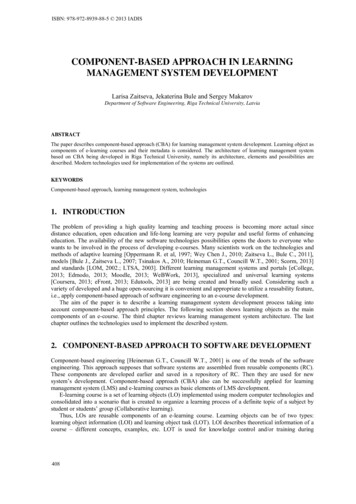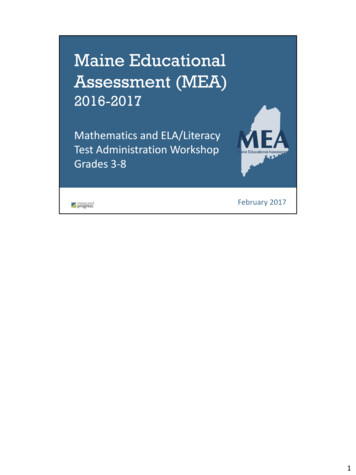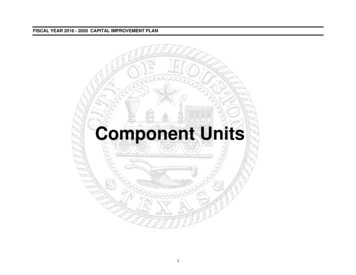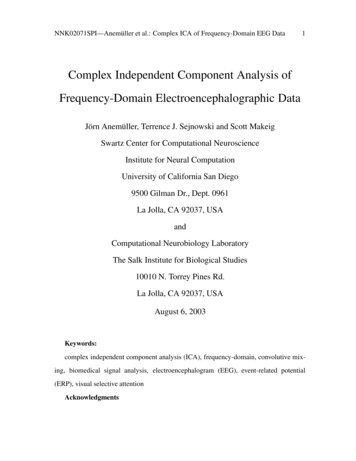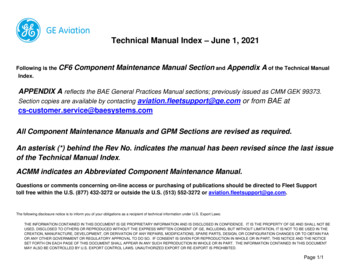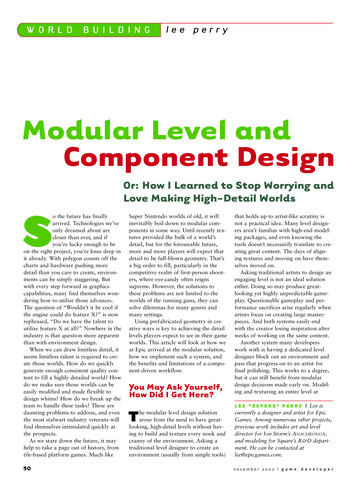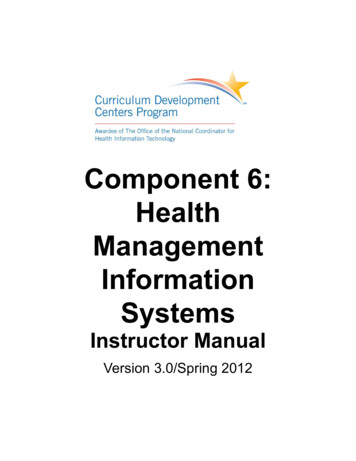
Transcription
Component 6:HealthManagementInformationSystemsInstructor ManualVersion 3.0/Spring 2012
Notes to InstructorsThis Instructor Manual is a resource for instructors using this component.Each component is broken down into units, which include the followingelements: Learning objectives Suggested student readings, texts, reference links to supplementthe narrated PowerPoint slides Lectures (voiceover PowerPoint in Flash format); PowerPoint slides(Microsoft PowerPoint format), lecture transcripts (Microsoft Wordformat); and audio files (MP3 format) for each lecture Self-assessment questions reflecting Unit Objectives with answerkeys and/or expected outcomes Application Activities (e.g., discussion questions, assignments,projects) with instructor guidelines, answer keys and/or expectedoutcomesHealth IT Workforce CurriculumHealth ManagementInformation SystemsVersion 3.0/Spring 2012This material was developed by Duke University funded by the Department of Health and Human Services, Office of theNational Coordinator for Health Information Technology under Award Number 1U24OC0000232
ContentsNotes to Instructors.2Component Overview.4Component Authors.5Disclaimer.6Component 6/Unit 1.7Component 6/Unit 2.12Component 6/Unit 3.17Component 6/Unit 4.23Component 6/Unit 5.28Component 6/Unit 6.35Component 6/Unit 7.40Component 6/Unit 8.45Component 6/Unit 9.52Component Acronym Glossary.58Creative Commons Attribution-NonCommercial-ShareAlike 3.0 Unported .68Health IT Workforce CurriculumHealth ManagementInformation SystemsVersion 3.0/Spring 2012This material was developed by Duke University funded by the Department of Health and Human Services, Office of theNational Coordinator for Health Information Technology under Award Number 1U24OC0000233
Component OverviewEach Learning Unit requires 2-3 contact (or instructional) hours and anadditional 6-9 hours of independent or team work on the part of the student to be successfully completed. Each unit contains more material thanwould likely be used in any one teaching/learning experience so that theinstructor can pick and choose material most applicable to local workforceneeds.Content covering Hardware and Software Supporting Health InformationSystems can be found in Component 4.Content covering Human-Computer Interaction can be found in Component 15.Content covering Public Health and Biosurveillance in Health Care Systems can be found in Component 13.This entire Component is estimated to require 20-30 total contact/instructional hours plus 50-65 additional hours of independent or team work, depending on the learning activities and assessments used within each unit.Component ObjectivesAt the completion of this component, the student will be able to: Describe general functions, purposes and benefits of health information systems in various health care settings Describe the federal initiatives and other significant developmentsthat have influenced the evolution and adoption of health information systems Compare/Contrast different types of health information systems interms of their ability to meet the needs of various types of healthcare enterprises Explain how electronic health records affect patient safety, qualitycare, efficiency, productivity, and reporting/documentation mechanisms Propose strategies to minimize major barriers to the adoption ofelectronic health records Explain how the principles of health care data exchange and healthcare data standards relate to patient care, productivity and dataanalysisHealth IT Workforce CurriculumHealth ManagementInformation SystemsVersion 3.0/Spring 2012This material was developed by Duke University funded by the Department of Health and Human Services, Office of theNational Coordinator for Health Information Technology under Award Number 1U24OC0000234
Component AuthorsAssigned InstitutionDuke University, Durham, NCTeam LeadKathy Giannangelo, MA, RHIA, CCS, CPHIMS, FAHIMAPitt Community CollegePrimary Contributing AuthorsConstance M. Johnson, MS, PhD, RNDuke UniversitySandra Crockett, RHIAPitt Community CollegeLecture Narration/Sound EngineerRaland Technologies LLC1387 Fairport RoadSuite 1050 Fairport, NY 14450David Flass – Project ManagerTeam MembersBrian Reynolds, PhDProject Lead, Duke Translational Research InstituteDuke UniversityHealth IT Workforce CurriculumHealth ManagementInformation SystemsVersion 3.0/Spring 2012This material was developed by Duke University funded by the Department of Health and Human Services, Office of theNational Coordinator for Health Information Technology under Award Number 1U24OC0000235
DisclaimerThese materials were prepared under the sponsorship of an agency of theUnited States Government. Neither the United States Government nor anyagency thereof, nor any of their employees, makes any warranty, expressor implied, or assumes any legal liability or responsibility for the accuracy,completeness, or usefulness of any information, apparatus, product, orprocess disclosed, or represents that its use would not infringe privatelyowned rights. Reference herein to any specific commercial product, process, or service by trade name, trademark, manufacturer, or otherwisedoes not necessarily constitute or imply its endorsement, recommendation, or favoring by the United States Government or any agency thereof.The views and opinions of authors expressed herein do not necessarilystate or reflect those of the United States Government or any agencythereof.Likewise, the above also applies to the Curriculum Development Centers(including Columbia University, Duke University, Johns Hopkins University,Oregon Health & Science University, University of Alabama at Birmingham, and their affiliated entities).Health IT Workforce CurriculumHealth ManagementInformation SystemsVersion 3.0/Spring 2012This material was developed by Duke University funded by the Department of Health and Human Services, Office of theNational Coordinator for Health Information Technology under Award Number 1U24OC0000236
Component 6/Unit 1Unit TitleWhat is Health Informatics?Unit DescriptionLecture a defines information management, information technology, andinformatics, describes the fundamental theorem of informatics, explainsthe meaning of biomedical and health informatics as a field of study, andoffers definitions of the major biomedical informatics areas of applications.It also provides an overview of informatics drivers and trends in the healthcare field. Lecture b defines the informatics team, their skills, roles andresponsibilities, and identifies how health informaticians process data intoinformation and knowledge for health care tasks with the support of information technology to improve patient care.Unit ObjectivesBy the end of this unit the student will be able to:1. Define information management, information system (technology) and informatics2. Explain the basic theoretical concept that underlies informatics practice3. Define the meaning of biomedical and health informatics asa field of study4. Describe the biomedical informatics areas of applications5. Summarize the informatics drivers and trends6. State the professional roles and skills of health informaticians7. Identify how health informaticians process data into information and knowledge for health care tasks with the support ofinformation technology to improve patient careUnit Topics / Lecture Titles1a Introduction to Health Informatics1b Roles and Skills of Health InformaticiansUnit References(All links accessible as of 12/13/2011)Health IT Workforce CurriculumHealth ManagementInformation SystemsVersion 3.0/Spring 2012This material was developed by Duke University funded by the Department of Health and Human Services, Office of theNational Coordinator for Health Information Technology under Award Number 1U24OC0000237
Lecture 1a1. Altman, R. B., & Mooney, S. D. (2001). Bioinformatics. In Shortliffe.E., & Cimino, J.J. (Eds.), Biomedical informatics: Computerapplications in health care and biomedicine (3rd ed.) (p. 763. NewYork, NY: Springer Science Business Media.2. American Health Information Management Association. (2012).Pocket glossary for health information management and technology(3rd ed.). Chicago, IL: Author.3. AMIA. (2011). About AMIA. Retrieved from http://www.amia.org/about-amia4. AMIA’s Academic Forum. (n.d.). Definition of biomedical informatics.Retrieved from petencies5. Bernstam E., Smith J., & Johnson T. (2009, August). What isbiomedical Informatics. Journal of Biomedical Informatics, 43(1).doi: 10.1016/j.jbi.2009.08.0066. Friedman, C. (2009). A “fundamental theorem” of biomedicalinformatics. Journal of the American Medical InformaticsAssociation, 16(2), 169-170. doi: 10.1197/jamia.M30927. Healthcare Information and Management Systems Society. (2003,May 5). HIMSS E-Health SIG white paper. Retrieved from http://www.himss.org/content/files/ehealth whitepaper.pdf*8. Merriam-Webster Online. (2011). Retrieved from . Rowley, J. (2007, February). The wisdom hierarchy: Representationsof the DIKW hierarchy. Journal of Information Science, 44. doi:10.1177/016555150607070610. Shortliffe, E., & Blois, M. (2006). The computer meets medicineand biology: Emergence of a discipline. In Shortliffe. E., & Cimino,J.J. (Eds.), Biomedical informatics: Computer applications in healthcare and biomedicine (3rd ed.) (pp. 3-45). New York, NY: SpringerScience Business Media.11. The National Alliance for Health Information Technology. (2008,April 28). Defining key health information technology terms.Retrieved from healthit.hhs.gov/portal/server.pt/gateway/PTARGS 0 10741 848133 0 0 18/10 2 hit terms.pdf12. UMDNJ-Robert Wood Johnson Medical School, UMDNJSchool of Health Related Professions Department of HealthInformatics & New Jersey Institute of Technology. (n.d.). MD/MS in Biomedical Informatics. [Brochure]. Retrieved from*Indicates this link is no longer functional.Health IT Workforce CurriculumHealth ManagementInformation SystemsVersion 3.0/Spring 2012This material was developed by Duke University funded by the Department of Health and Human Services, Office of theNational Coordinator for Health Information Technology under Award Number 1U24OC0000238
http://rwjms.umdnj.edu/education/current students/academics/mdms biomedicalinformatics.pdf*13. U.S. Department of Health and Human Services, TheOffice of the National Coordinator for Health InformationTechnology. (2009, December 4). Health IT terms.Retrieved from http://healthit.hhs.gov/portal/server.pt?open 512&mode 2&cached true&objID 1256&PageID 15726*14. World Health Organization. (2011). eHealth. Retrieved from http://www.who.int/topics/ehealth/en/Lecture 1a Charts, Tables and Figures1.1 Figure: Friedman, C. (2009). A “fundamental theorem” of biomedical informatics. Journal of the American Medical Informatics Association,16(2), 169-170. doi: 10.1197/jamia.M30921.2 Figure: Biomedical Informatics: Modified by Dr. Jiajie Zhang, TheUniversity of Texas at Houston, School of Biomedical Informatics fromShortliffe, E., & Blois, M. (2006). The computer meets medicine and biology: Emergence of a discipline. In Shortliffe, E., & Cimino, J.J. (Eds.), Biomedical informatics: Computer applications in health care and biomedicine(3rd ed.) (pp. 3-45). New York, NY: Springer Science Business Media.Lecture 1b1. AMIA. (2011). The clinical informatics subspecialty. Retrieved al-subspecialty2. Department of Health and Human Services, National Libraryof Medicine. (2011). Institutional grants for research training inbiomedical informatics (T15). Retrieved from M-06-001.html3. Friedman, C. P., Altman, R. B., Kohane, I. S., McCormick, K.A., Miller, P. L., Ozbolt, J. G., Williamson, J. (2009). Trainingthe next generation of informaticians: The impact of ‘‘BISTI’’and bioinformatics—A report from the American College ofMedical Informatics. Journal of the American Medical InformaticsAssociation, 11, 167-172. doi: 10.1197/jamia.M15204. Shortliffe, E., & Blois, M. (2006). The computer meets medicineand biology: Emergence of a discipline. In Shortliffe. E., & Cimino,J.J. (Eds.), Biomedical informatics: Computer applications in healthcare and biomedicine (3rd ed.) (pp. 3-45). New York, NY: SpringerScience Business Media.*Indicates this link is no longer functional.Health IT Workforce CurriculumHealth ManagementInformation SystemsVersion 3.0/Spring 2012This material was developed by Duke University funded by the Department of Health and Human Services, Office of theNational Coordinator for Health Information Technology under Award Number 1U24OC0000239
5. University of Mi
Define information management, information system (tech-nology) and informatics 2. Explain the basic theoretical concept that underlies informat- ics practice 3. Define the meaning of biomedical and health informatics as a field of study 4. Describe the biomedical informatics areas of applications 5. Summarize the informatics drivers and trends 6. State the professional roles and skills of .
